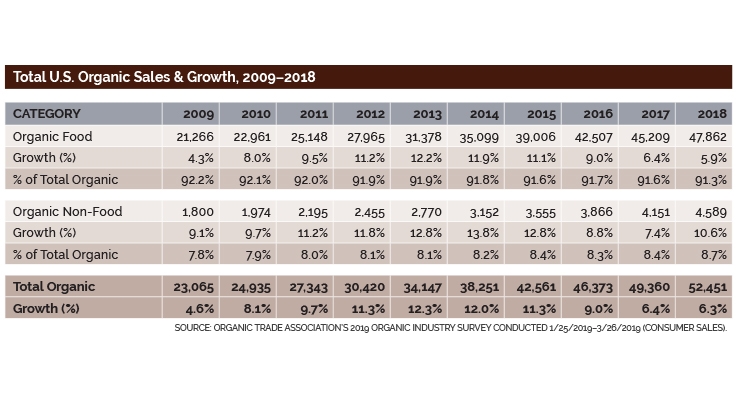Market Updates
U.S. Organic Sales Top $50 Billion in 2018
Organic food sales reached $47.9 billion, growing about 6%, according to Organic Trade Association survey.

By: Sean Moloughney
Editor

Sales of organic products continue to climb as consumers associate them with terms and ideas like clean, transparent, fresh, sustainable, environmentally friendly, humane to animals, high quality, and social activism.
The U.S. organic market in 2018 broke through the $50 billion mark for the first time, with sales hitting a record $52.5 billion, up 6.3% from the previous year, according to the 2019 Organic Industry Survey released by the Organic Trade Association.
New records were made in both the organic food market and the organic non-food market. Organic food sales reached $47.9 billion, for an increase of 5.9%. Sales of organic non-food products jumped by 10.6% to $4.6 billion. The growth rate for organic continued to easily outpace the general market: in 2018, total food sales in the U.S. edged up just 2.3% while total non-food sales rose 3.7%.
Millennials are pushing for transparency and integrity in the food supply chain, and they are savvy to misleading marketing. The USDA Organic seal is gaining new appeal as consumers realize that organic is a certification that is not only monitored and supported by official standards, but is the only seal that encompasses the spectrum of Non-GMO, no toxic pesticides or chemicals, dyes or preservatives.
Almost 6% (5.7%) of the food sold in the U.S. is now organic. Today’s consumers can find organic products—food and non-food items—in every aisle of their grocery stores. They can choose organic in their favorite big box store, their club warehouse store, even in their neighborhood convenience store, and increasingly on the Internet. Organic is no longer a niche market.
“Organic is now considered mainstream. But the attitudes surrounding organic are anything but status quo,” said Laura Batcha, CEO and executive director of the Organic Trade Association. “In 2018, there was a notable shift in the mindset of those working in organic toward collaboration and activism to move the needle on the role organic can play in sustainability and tackling environmental initiatives.”
“Activism is a natural reaction from an industry that is really close to the consumer. When we are in an environment where government is not moving fast enough, the industry is choosing to move to meet the consumer rather than get stalled,” said Batcha.
Produce Still Reigns Supreme
Still the stalwart of the organic industry, sales of organic fruits and vegetables rose to $17.4 billion in 2018 for a 5.6% rate of growth, on par with the growth attained in 2017. By comparison, the overall fruits and vegetables category, including both organic and conventional products, grew by just 1.7% in 2018.
Fruits and vegetables now account for 36.3% of all organic food sales. Organic fruits and vegetable make up close to 15% (14.6%) of all the produce sold in the U.S., and have nearly doubled their market share in the last 10 years.
Produce is a gateway to organic for consumers, especially millennials and those with young families. Industry experts note that the more people learn about health and wellness, the more people buy fresh produce.
Popular in the organic produce aisles: the classics like carrots, greens, apples, bananas. Also hitting stride are organic berries, avocados, brussel sprouts, cauliflower and tropical fruits like mangoes and papayas. And outside the fresh produce section, the frozen, canned, and dried vegetable and fruit sections also made gains.

Innovation Key for Organic Dairy
Shoppers, especially young families, are increasingly seeking out products made from high-quality simple ingredients from brands committed to sustainable agriculture and its environmental benefits. Those shoppers turn to organic dairy as a trusted clean product free of antibiotics, synthetic hormones and chemicals. But growth in the U.S. dairy sector slowed for the second straight year due largely to shifting diet trends. Still the second-largest organic category, dairy and egg sales were $6.5 billion in 2018, up 0.8% from 2017.
Although growth in organic egg sales has slowed from the strong double-digit growth seen in the first part of this decade, the $858 million category still grew by a solid 9.3% in 2018. As more consumers get into organic, organic egg demand is expected to continue growing.
But where skim milk and low fat products were not so long ago favored by consumers, products high in healthy fats and protein are now popular. Many millennials have also moved away from livestock-based products toward plant-based foods and beverages. Experts said that to satisfy today’s consumer, the importance of innovation in the organic dairy sector has never been greater. In 2018, the industry responded.
Reaching Beyond Food
Consumers are making the connection that the same reasons they choose to eat organic food apply to the non-food products they use—whether napkins for their dinner table, food for their pets, lotions they put on their skin or the supplements they ingest. Consumers want clean labels and to reduce the chemical load on their bodies. Millennials also have a higher awareness around supply chain transparency and sustainability. All of these factors bode well for the future of the organic non-food industry.
In 2018, the organic non-food category reached $4.6 billion in sales with a growth rate of 10.6%. This rate is both well above the 7.4% growth rate reported in 2017, and the 3.6% growth rate reported in 2018 for the overall non-food industry (conventional and organic combined).
The strongest growth came from fiber, the largest of the non-food categories, which accounts for 40% of the organic non-food market. In 2018, fiber recorded $1.8 billion in sales, up from $1.6 billion in 2017.
Outlook for Innovation & Activism
The outlook for organic is not without its challenges, but all expectations are that innovation and activism by the organic industry will continue to build as the sector works to maintain the credibility of the organic seal and the trust of consumers.
“Organic is in a unique and tough environment. The government is slowing the advancement of the organic standard, but the positive news is that industry is finding ways to innovate and get closer to the consumer without walking away from the organic program—the sector is innovating yet requiring that federal organic be in place,” said Batcha. “So, whether it’s grass-fed, regenerative, or Global Organic Textile Standard certified, they all have to be organic. The industry is committed to standards and giving consumers what they want.”
This year’s survey was conducted from January through April 2019 and produced on behalf of the Organic Trade Association by Nutrition Business Journal (NBJ). More than 200 companies completed a significant portion of the in-depth survey.


